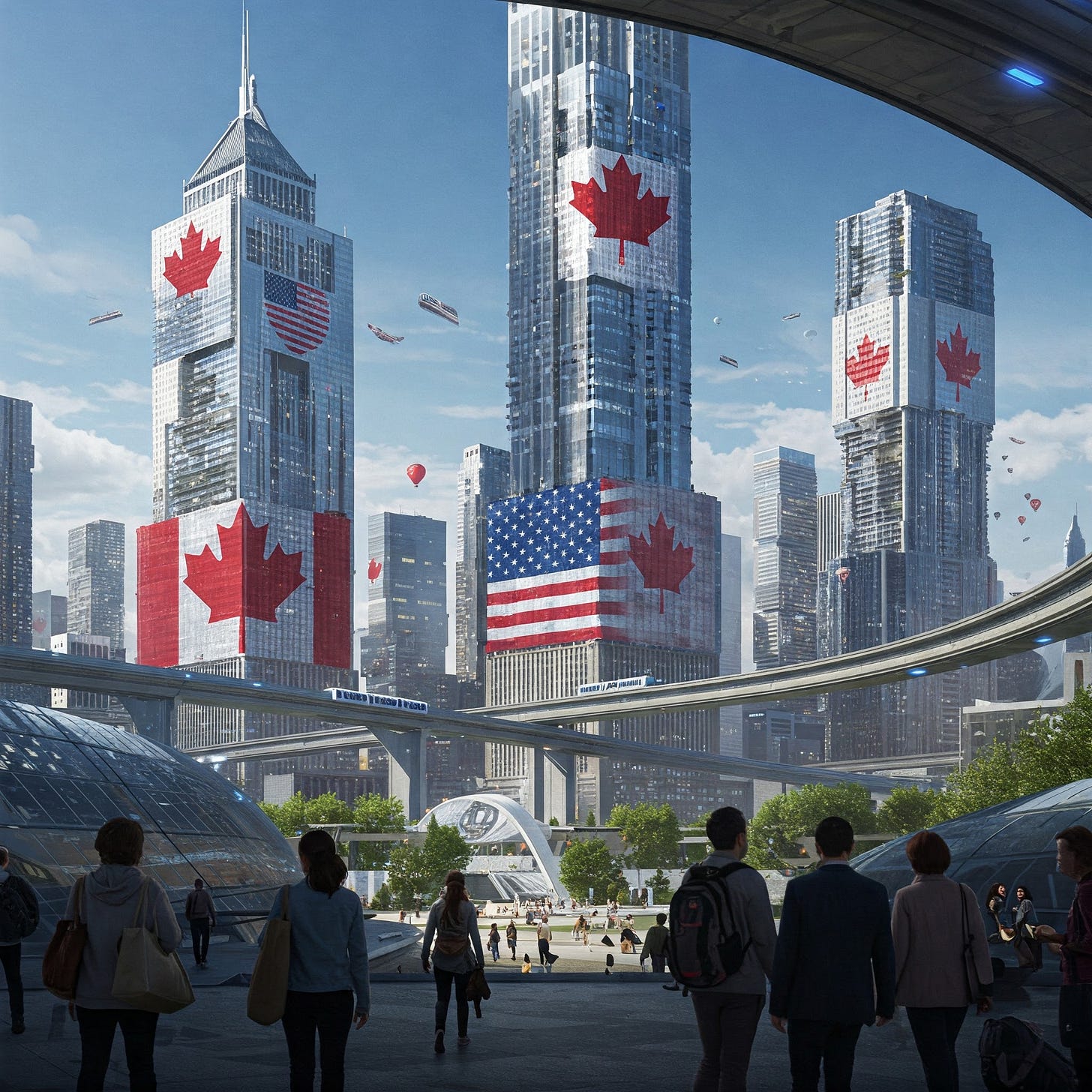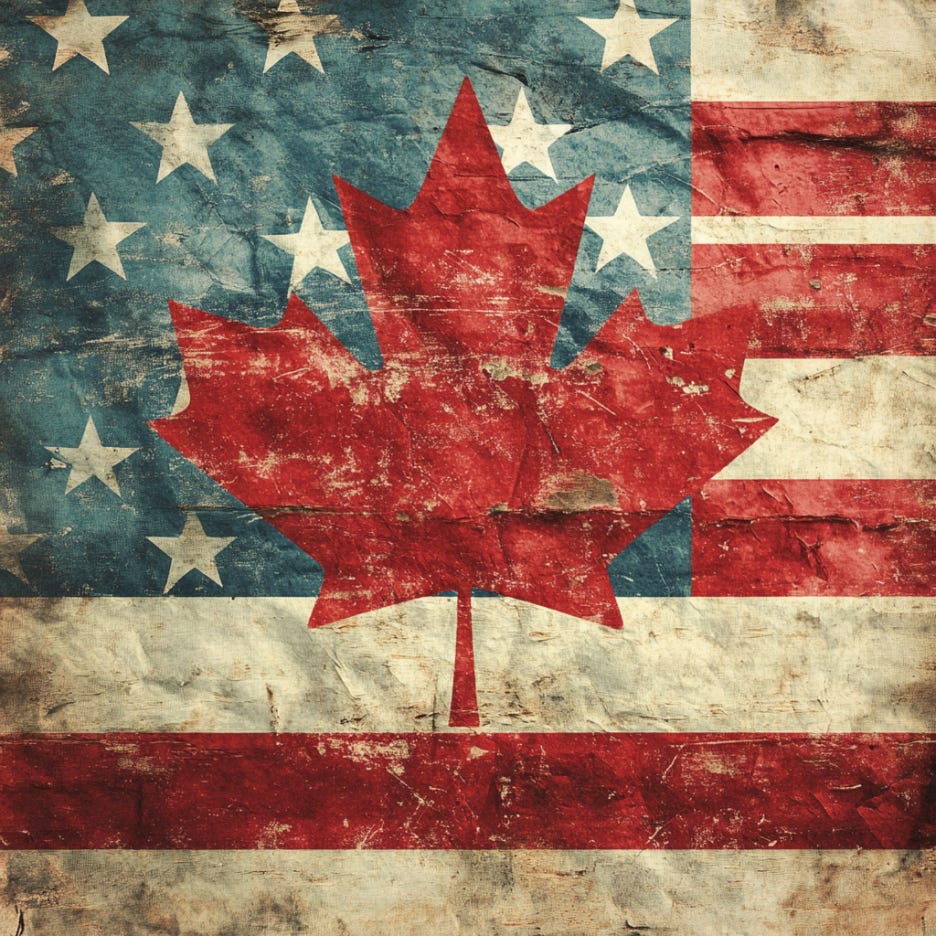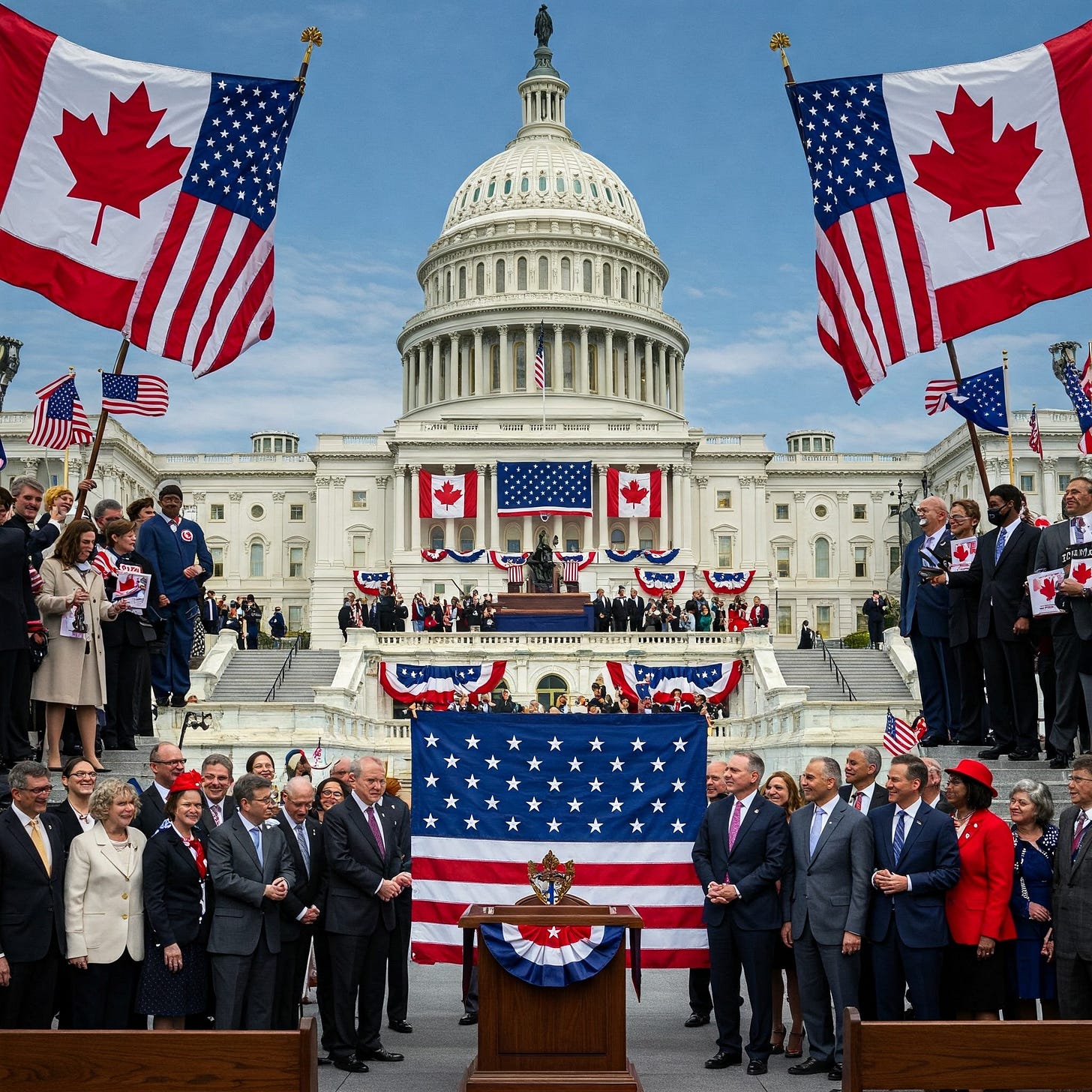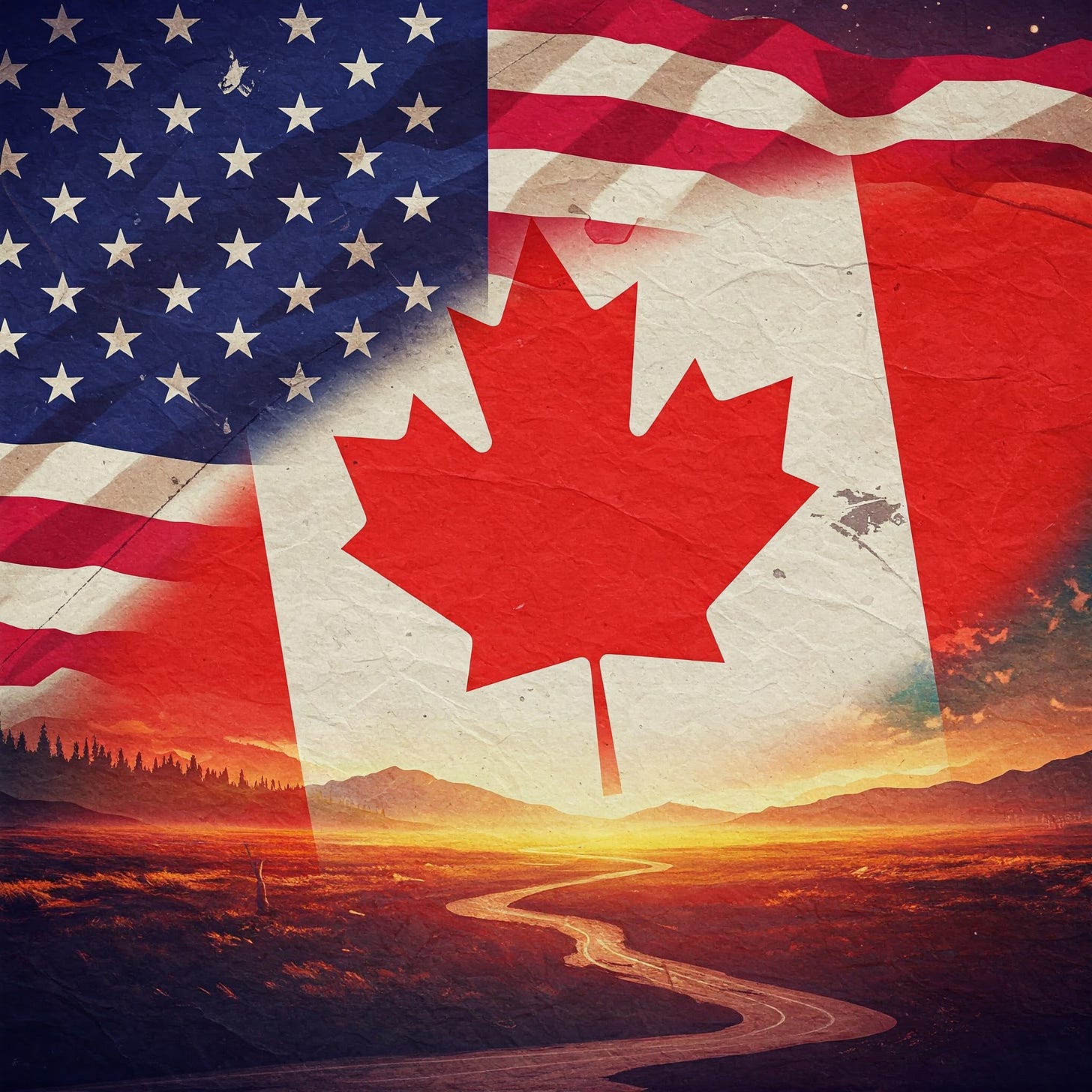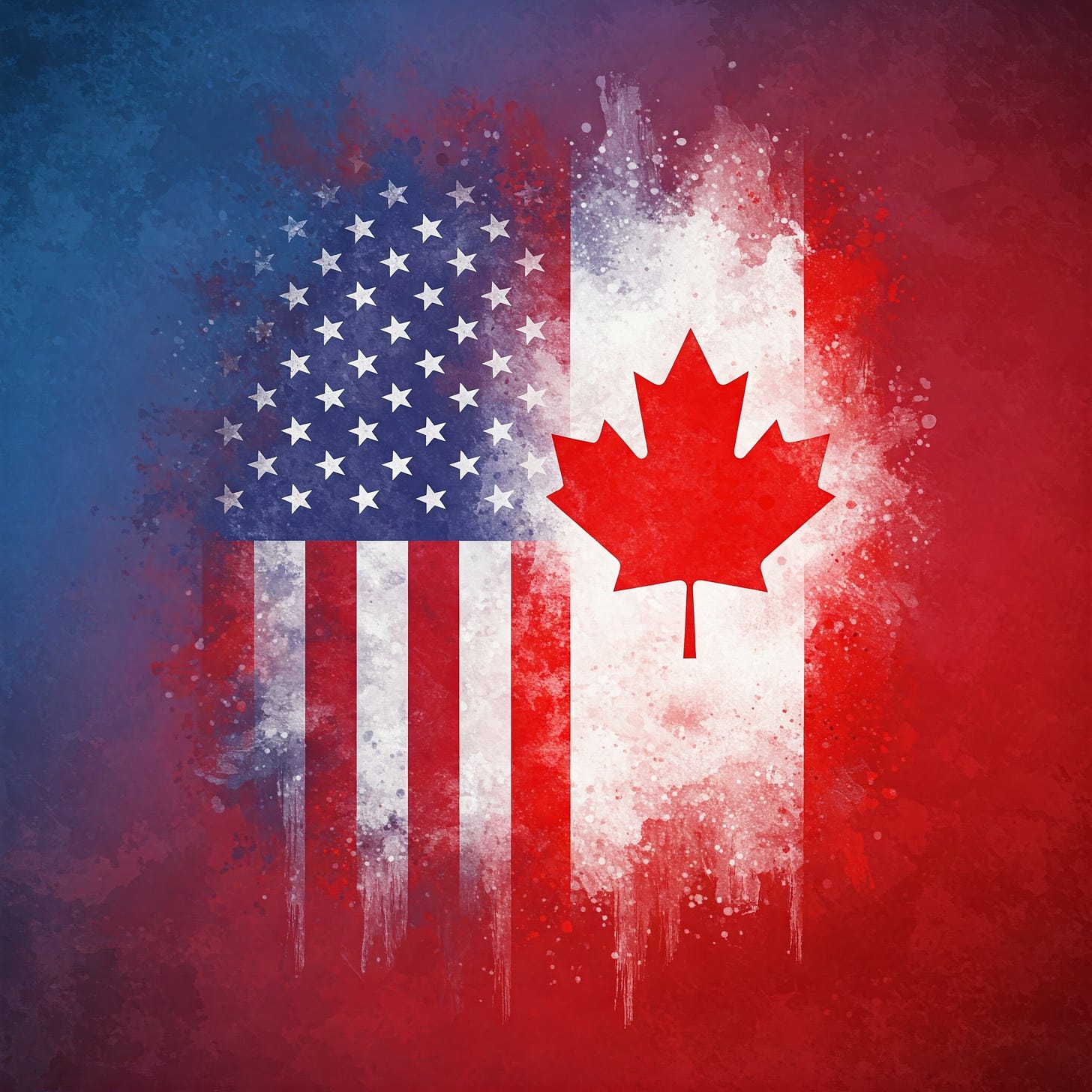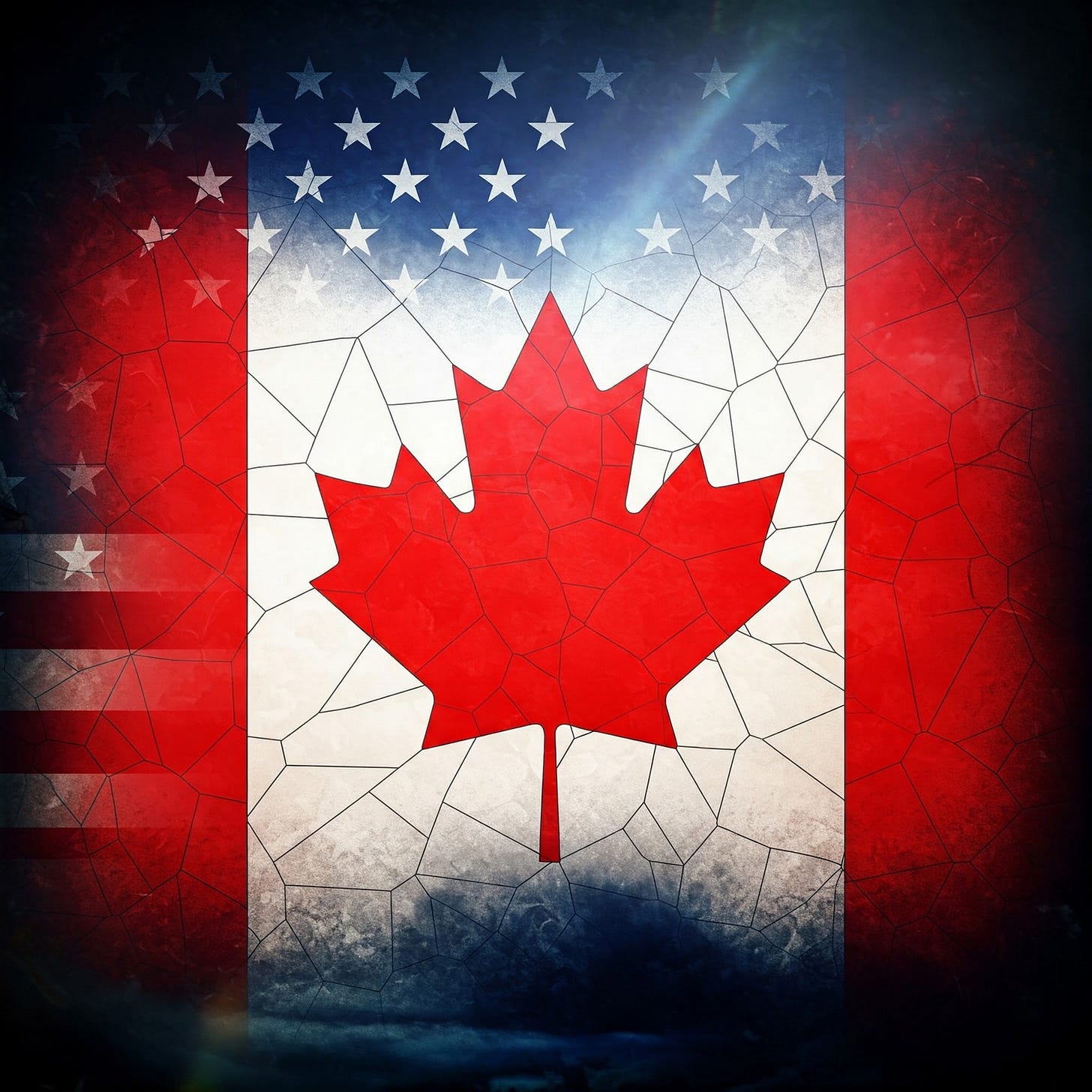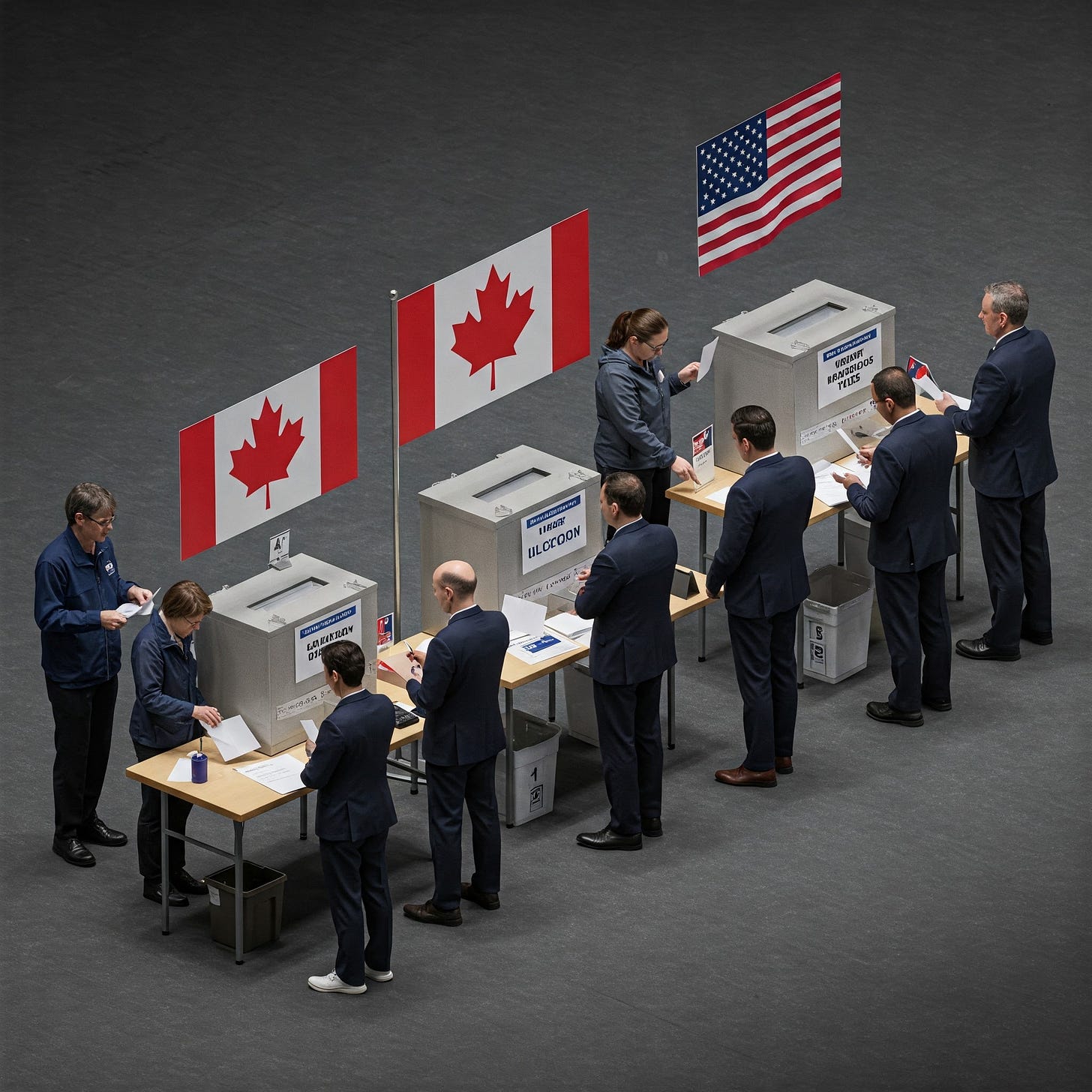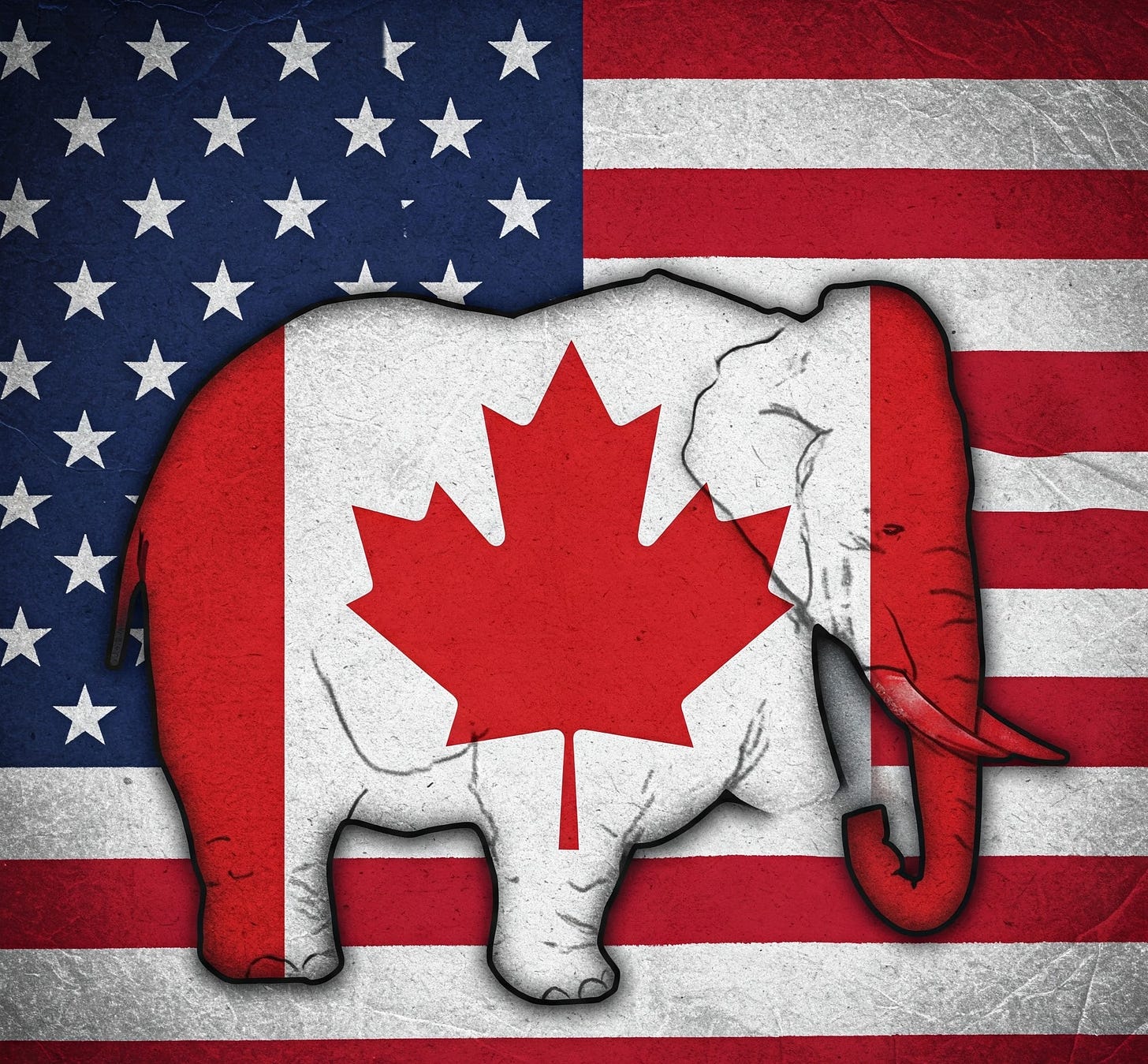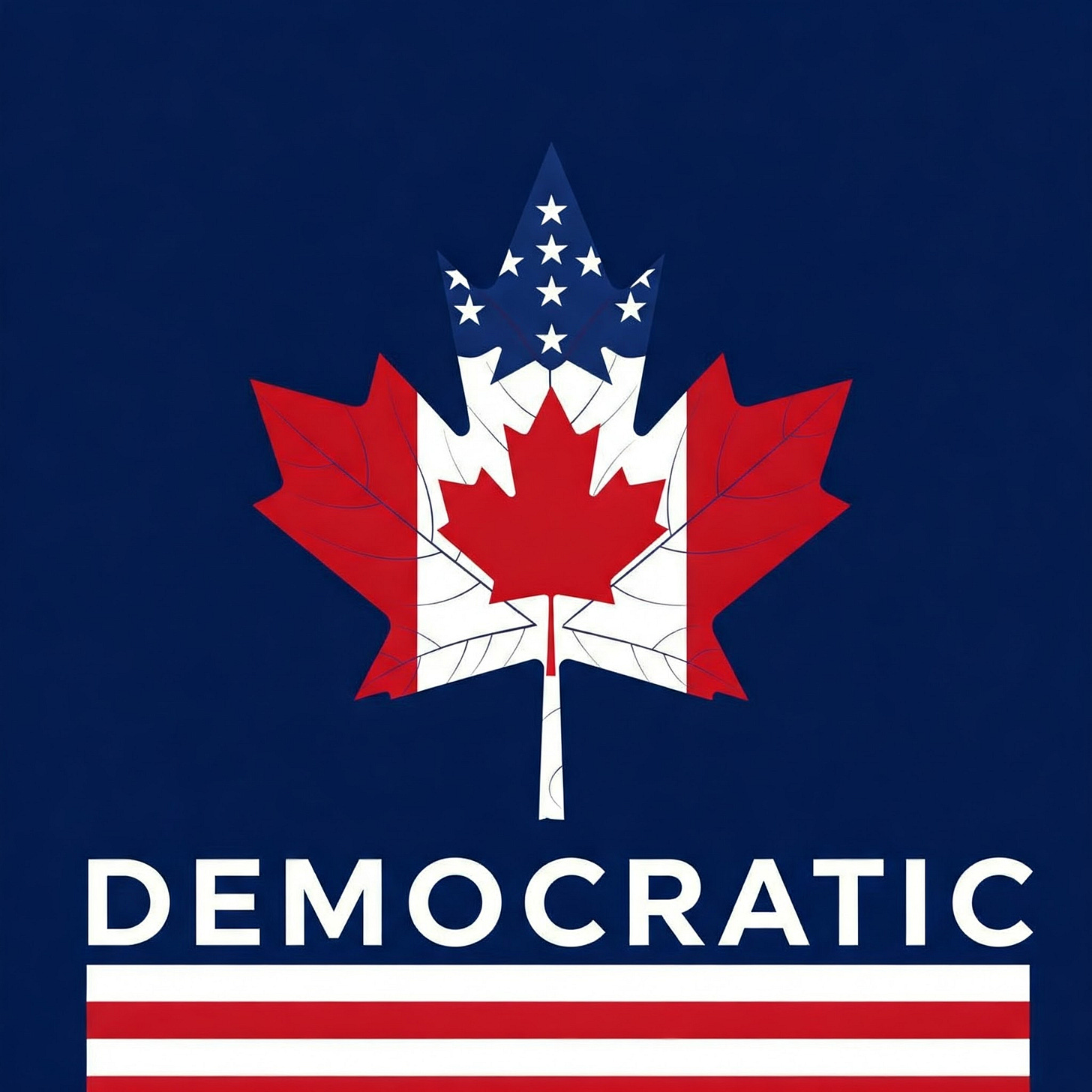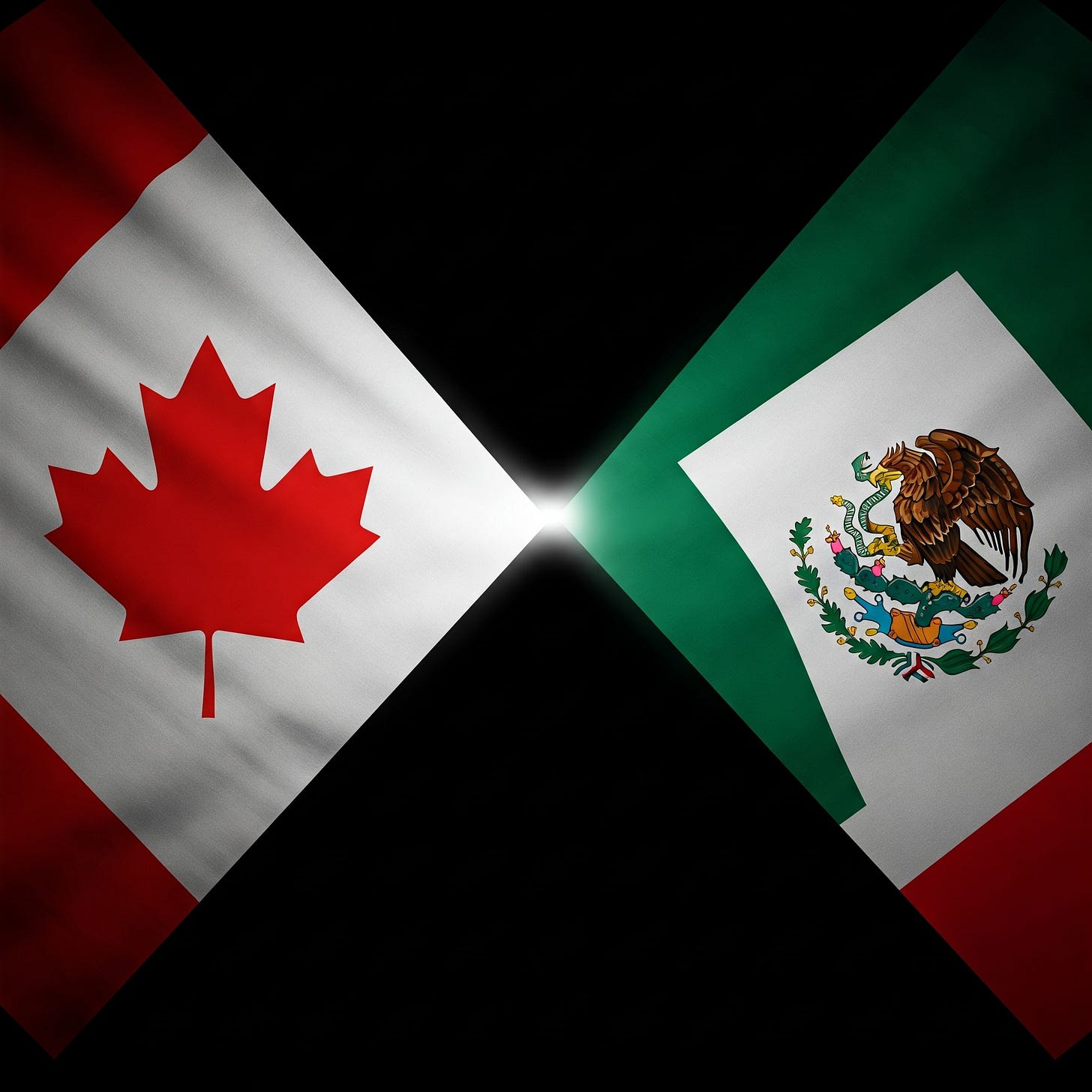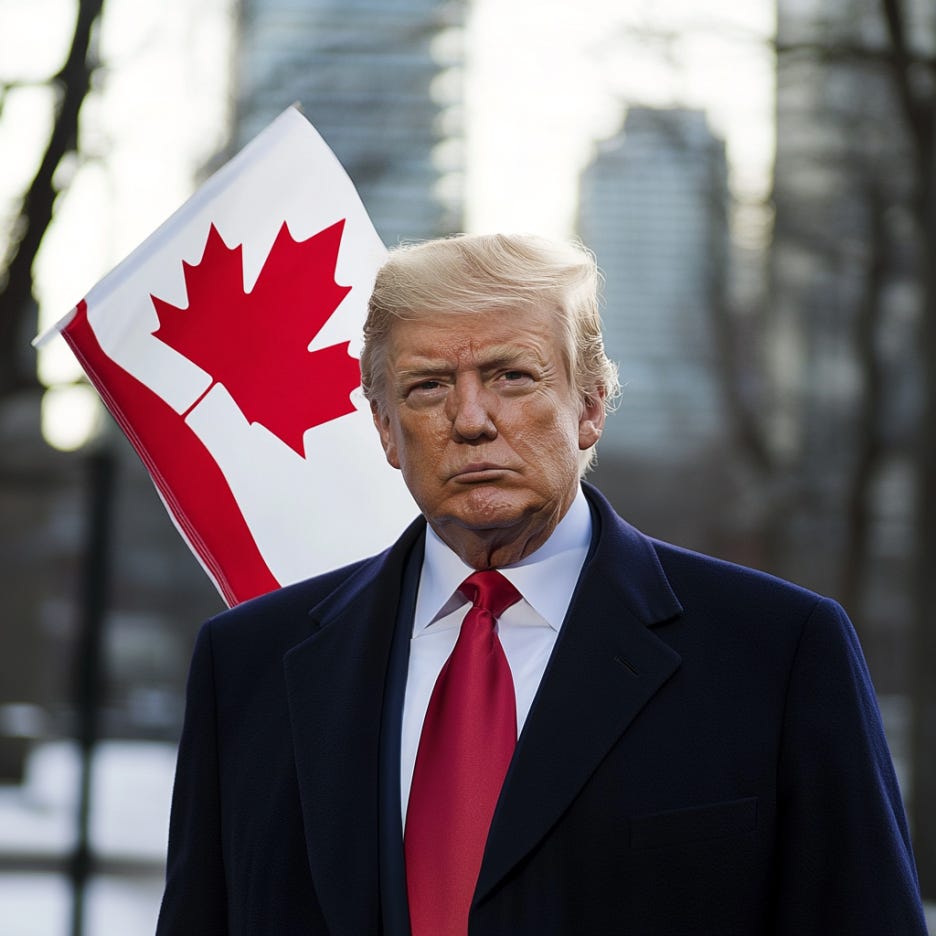U.S. Annexation of Canada: Joining as a 51st State Would be a Big "Win-Win" - Yet Unlikely Despite Trump's Pressure
The U.S. subsidizes Canada heavily via military/defense, pharma/tech IP, access to the U.S. market, uneven trade deals, and more... would be a win-win if Canada joined as a 51st state
When Trump floated the idea to annex Canada — such that they’d become the 51st state of America, I laughed. I still laugh when Trump goes on his intermittent rants about the U.S. heavily subsidizing Canada and how Canada would be much better off as America’s 51st state.
Trump is telling the truth here… Canada joining the United States would be a big win-win (Canada would likely benefit disproportionately more than the U.S.). The countries are similar enough to make annexation work… whereas annexing a country like Mexico would be a massive net negative headache for the U.S.
I’ve written about exploitation of the U.S. by allies in 2025 (NATO, defense, trade, IP theft or subsidy, global institutions, etc.) and think that between Canada, Mexico, Europe, and China (not really an ally) — the U.S. is getting ripped off (taken to the cleaners) to the tune of ~$1+ TRILLION per year.
I’ve also highlighted the fact that recapturing even a fraction of this annual loss could transform American infrastructure, healthcare, and overall innovation. But parasitic relationships don’t go easy… something needs to be done.
Obviously the U.S. shouldn’t intentionally bail on its allies, but they should hold them accountable to fair trade practices/terms and contributions… most have gotten comfortable letting the U.S. do all of the heavy lifting because they indirectly subsidizes their socialist policies (free healthcare, low drug prices, free university, free housing, importing asylum seekers/refugees, zero innovation, heavy welfare state).
A potentially problem here is that if you get too aggressive with Canada it may turn to China… but this is inherently risky for Canada given China’s routine exploitation of countries (espionage, IP theft, pushing military boundaries, et al.) and logistical challenges (Canada wants the U.S. market)… so if you become reliant on Beijing, it could quickly morph into an asymmetrical “Chinese finger trap” (try pulling out after the deal but now you’re stuck).
The video above is classic Trump. Had me laughing to the point of tears — had to watch twice.
What do I think here? Trump legitimately would like Canada to join the U.S. (it would obviously be a win/win)… but he may know it’s unlikely to happen given Canada’s attitude/reaction to the offer.
He may be partially joking floating this idea though… perhaps he just wants to highlight how they are so reliant on the U.S. and take advantage of the U.S. — such that if they don’t become the 51st state, they should pay an annual toll of $75-100 billion for access to the U.S. market (due to lack of defense/military contributions, uneven trade/tariff terms, NATO contributions, pharma/tech IP leeching, R&D, etc.).
The trade war with Canada is a lose-lose situation… but, Canada should either: (1) voluntarily join the U.S. as a 51st state OR (2) contribute equally/fairly to the relationship (zero lopsided trade terms, no special pharma/IP deals, even defense/military/NATO spending, etc.). This is why Trump is holding Canada’s feet to the fire.
Canada regularly talks shit about the U.S. — many Canadians despise the U.S. and don’t realize that Canada, from a macro perspective, has long been ripping off the U.S. (extremely lopsided relationship & uneven contribution).
Trump may eventually cave due to backlash (assuming Canada doesn’t capitulate) and then come up with some “deal” that he markets as a “massive improvement” to stop the U.S. from getting ripped off by Canada (even if the deal isn’t much different than the prior arrangement).
I. Do Canadians Want to Join the U.S. in 2025 as a 51st State?
Not really. ~75-80% reject the idea. ~10-20% are open to a potential merger — especially younger Canadians ages 18-34 (~43%).
These numbers signal that a majority of Canadians would resist the idea of annexation by the U.S. — but the idea isn’t universally taboo.
Recent Polling Data
Overall Support
Angus Reid (Jan 2025): 10% of Canadians would vote to join the U.S. in a referendum.
Leger (Dec 2024): 13% outright back becoming the 51st state.
YouGov (Jan 2025): 15% support annexation.
While 75–80% reject or strongly oppose the idea across surveys, a persistent 10–15% minority endorses it in principle.
Conditional Scenarios
Abacus Data (Jan 2025): 24% are open to exploring a merger, though only 6% are “absolutely in favour.”
Ipsos (Feb 2025): 30% might consider joining if guaranteed U.S. citizenship and asset conversion; this jumps to 43% among adults aged 18–34.
Demographic & Regional Differences
By Political Affiliation: Conservative voters show up to 20% support, vs. <5% among Liberal, NDP, or Bloc Québecois voters.
Alberta & Saskatchewan: Highest regional support at 18–19%, driven by energy industry frustrations and a sense of cultural/ideological alignment with conservative American states.
Younger Canadians: Up to 43% in the 18–34 bracket say they’d at least consider annexation if economic benefits (e.g., immediate USD asset conversion) were guaranteed.
Estimated Numbers
Canada’s adult population is roughly 31 million. Even at a modest 10–15%, that equates to 3–4.6 million adults.
Higher figures (20–30% conditional) could represent 6–9 million exploring or “somewhat open” to the idea.
Reasons for Some Pro-Annexation Sentiment
Economic and Currency Stability: Some see potential personal gains if their assets were converted to U.S. dollars, especially in uncertain times for the Canadian currency. They anticipate improved job prospects and reduced trade barriers, particularly in energy-rich provinces like Alberta.
Defense & Security Alignment: A small subset favors aligning with the world’s foremost military power, ensuring Arctic defense and lower Canadian defense costs. Perceived “lack of representation” in Ottawa (especially in Western provinces) makes direct representation in Washington look appealing.
Cultural Similarities: English-speaking Canadians, especially near the border, feel culturally similar to neighboring U.S. states. Younger demographics, more exposed to American media, may view the American cultural sphere as a natural extension of their own.
Disillusionment with Ottawa: Polls suggest that some Canadians in Western provinces feel economically or politically marginalized, prompting them to flirt with alternative political arrangements.
Takeaway: Annexation scenarios are exceedingly rare—and, in modern geopolitics, nearly unprecedented for a G7 country—investigating them reveals the depth of U.S.-Canada ties. Most Canadians are strongly against the idea of joining the United States — but younger Canadians are more willing (over 40% in the 18-34 cohort).
II. Brief History of the U.S.-Canada Border & Relations
Colonial Rivalries (1600s–1700s)
French vs. British Presence: New France (1608–1763) included large parts of the St. Lawrence River Valley, the Great Lakes region, and territories stretching into the Mississippi watershed. Britain’s Thirteen Colonies along the Atlantic coast gradually expanded inland.
Seven Years’ War (1756–1763): Often called the “French and Indian War” in North America, this conflict ended in 1763 with the Treaty of Paris. Britain gained control of most French territories, effectively setting the stage for a British-dominated Canada.
American Revolution & Aftermath (1775–1783)
War of Independence: The American colonies revolted against British rule. Canada, still under British control, did not join the revolt.
Treaty of Paris (1783): Formally recognized the United States. Established boundaries (in part) between the new nation and British North America (future Canada), though many disputed areas remained.
Loyalist Migration: Loyalists (Americans loyal to the Crown) fled north, shaping early Canadian identity with a pro-British stance.
Defining the 49th Parallel (1818, 1846)
Convention of 1818: Established the 49th parallel from Lake of the Woods westward to the Rocky Mountains as the boundary between U.S. and British territory in North America.
Oregon Treaty (1846): Extended this 49th parallel boundary to the Pacific Ocean, except for Vancouver Island, which remained wholly British.
Resulting Clarity: While the line might look “arbitrary,” it was a deliberate diplomatic compromise, providing a neat latitudinal demarcation.
Formation of Modern Canada (1867–1900s)
Canadian Confederation (1867): The British North America Act united Ontario, Quebec, Nova Scotia, and New Brunswick into the Dominion of Canada on July 1, 1867. Over time, other provinces and territories joined, stretching Canada’s domain from the Atlantic to the Pacific and eventually into the Arctic.
Alaska Boundary Dispute (1867–1903): After the U.S. purchased Alaska from Russia in 1867, negotiations and arbitration in 1903 finalized the boundary between Canada and Alaska.
20th Century to Present: Generally stable, peaceful relations between the U.S. and Canada, evolving into close trade and military partnerships (e.g., NORAD in 1958, NAFTA in the 1990s → replaced by USMCA in 2020).
Overall Relationship: The U.S.-Canada border is now the longest undefended land border worldwide. Historically, large-scale conflicts between the two largely ended by the early 19th century. Ties deepened further with WWII alliances and postwar economic integration.
III. How the U.S. Subsidizes Canada (Quantified Estimates)
Though many economists reject Trump’s claim that the U.S. subsidizes Canada to the tune of $200B annually, there are several dimensions in which the United States expends resources or grants concessions from which Canada substantially benefit — often without proportional reciprocation.
A.) Defense Spending & Security
NATO & Continental Defense Gap
Canada’s defense spending sits around 1.3–1.4% of GDP (roughly $28–$32B annually), well under NATO’s 2% target.
In contrast, the U.S. defense budget exceeds 3.5% of its GDP, topping $800B annually.
Shortfall for Canada (if it were to meet 2%): ~$15B/year. Many U.S. policymakers argue the U.S. effectively “covers” this shortfall in North American defense obligations (NORAD, Arctic security, advanced air defense).
Continental Defense Overhead
Through NORAD and other joint structures, the U.S. maintains the lion’s share of North American early-warning systems, strategic bombers, missile defense, etc.
Rough incremental cost attributed to covering Canada’s lesser role: typically $8–$12B per year (very approximate), since the U.S. fields more advanced capabilities that Canada relies on.
Total Defense “Subsidy” Range
Combining NATO shortfall ($15B) plus the incremental overhead from strategic assets ($8-12B), one might argue that $23–$27B of U.S. defense spending is effectively filling Canada’s gap each year.
Critics call this a “subsidy” because Canada reaps similar or equal defense benefits for substantially less outlay.
B.) Trade Deficit & Market Access
Merchandise Deficit
The U.S. frequently runs a goods trade deficit with Canada (often cited around $40–$70B), driven by energy imports, automotive parts, and forestry products.
Politically, some interpret deficits as “unfair,” framing them as the U.S. “subsidizing” Canadian producers through high demand.
Services Offset
The U.S. often runs a surplus in services (IT, financial, tourism), but that surplus is smaller (~$30B) than the goods deficit in many years.
Net deficits in goods + services combined can still be $10–$40B.
One-Sided Tariff Structures
Certain protected sectors in Canada (e.g., dairy) impose tariffs as high as 200–300% on U.S. imports. This costs U.S. producers an estimated $2–$3B annually, reinforcing the narrative that Canada restricts U.S. market access more than vice versa.
Softwood lumber disputes result in recurring U.S. tariffs on Canadian lumber, but critics in the U.S. say the underlying problem is “unfair” Canadian provincial stumpage fees, effectively subsidizing Canadian lumber exports.
RELATED: Trump’s 2025 “America First” Tariffs (MX, EU, CA, CN)
Putting a Dollar Figure on “Uneven” Trade
If one simply focuses on the persistent net goods deficit (say $40B) plus lost opportunities from Canadian high tariffs in certain sectors ($2–$3B), one might approximate a $42–$45B “trade advantage” for Canada each year.
However, many economists caution that trade deficits do not inherently equate to “subsidies.” They reflect patterns of comparative advantage and consumer demand.
Note: I don’t agree with the idea that “trade deficits” automatically equal uneven or unfair. It’s all about the terms. If the terms/conditions are even/fair, the “deficits” are arguably irrelevant.
C.) Pharmaceutical & IP Concessions
Lower Drug Prices for Canadians
Canada’s price regulations allow pharmaceuticals to be sold 30–60% cheaper than in the U.S. The shortfall in revenues for U.S. pharma is sometimes pegged at $2–$5B annually.
Industry estimates vary, but U.S. lobbying groups often cite $3–$4B as the direct difference in annual returns from the Canadian market vs. if Canada adhered to typical U.S. price levels.
Tech & Software IP
U.S. technology firms operate in Canada, but some point to looser patent enforcement and tax policies that disadvantage U.S. innovators or allow “free-riding.”
While harder to pin down, $1–$2B annually might be a conservative estimate of lost or reduced IP-related revenue for U.S. tech giants due to Canada’s fewer patent protections or differences in enforcement.
The Uneven Relationship: Canada Exploiting the U.S.?
Consolidated Range: From these simplified (and partly overlapping) estimates, one might argue $35–$70B in net benefits that Canada receives annually from the U.S. on defense, trade “advantages,” and IP-related concessions.
Caveat: Trump’s $200B figure appears well above even a generous sum of these categories. However, taken together, they do suggest a non-trivial asymmetry.
RELATED: A Hypothetical “America First” Reciprocity Act Blueprint to End Exploitation of the U.S.
IV. Canada no longer pulling its own weight?
A.) Defense vs. Social Programs
Resource Allocation
Canada’s much lower defense budget frees billions of dollars for universal healthcare, education, and other social programs.
Critics’ Argument: If Canada had to fund a military proportional to U.S. commitments, social program spending would shrink, revealing an indirect reliance on American military might.
Trump’s & Allies’ Narrative
In political speeches, Donald Trump and aligned commentators often highlight this dynamic: “Canada can afford generous welfare because the U.S. secures their continent.”
This resonates with some American voters who perceive it as an unfair arrangement.
B.) U.S. Market Reliance & “Parasitic” Framing
Heavy Export Dependence on the U.S.
Over 70% of Canada’s merchandise exports go to the United States.
Canada’s domestic industries—energy, automotive, forestry—are deeply integrated with U.S. supply chains. Some critics say this reliance amounts to Canada “piggybacking” on the larger U.S. market.
Productive vs. Parasitic?
Economists typically view this interdependence as normal for neighboring economies.
More hawkish voices see it as Canada being “parasitic”—i.e., reaping the benefits of U.S. consumer demand without matching contributions in defense or IP-driven research.
C.) Trump’s $200B Claim vs. Actual Estimates
Disputed “Subsidy” Levels: Many Canadian and American economists argue that no recognized dataset supports $200B specifically. More moderate tallies (like $50–$100B) still underscore asymmetry.
Why the Perception Matters: Even if the true figure is closer to $75B than $200B, the idea that the U.S. “does more” while Canada “relies” on it helps fuel annexation rhetoric and demands for trade renegotiations.
D.) Public Sentiment in Both Countries
United States
Segments of the American public, especially in conservative circles, often support calls for Canada to “pay its fair share” in defense or IP.
The annexation idea periodically surfaces as a dramatized solution to “stop subsidizing” Canada or to fold Canada’s resources under direct U.S. control.
Canada
Canadian politicians dispute the notion of free-riding, pointing to Canada’s robust contributions to peacekeeping, Arctic patrols, and integrated supply chains.
Most Canadians firmly oppose any suggestion of losing sovereignty, though pockets of frustration exist (particularly in energy-producing provinces) over perceived federal mismanagement, which can make U.S. alignment rhetorically appealing.
V. Why a U.S.-Canada Merger or Annexation Would be a “Win-Win”
Although annexation of a G7 nation is unprecedented and politically far-fetched, there are potentially significant mutual gains if the U.S. and Canada were to unify.
A.) Gains for Canada
Full Access to the U.S. Market
Current Friction: While Canada already enjoys favorable terms under USMCA, there are still disputes (softwood lumber, dairy) and occasional tariff flare-ups.
Annexation Impact: Canadian producers would gain frictionless access (no tariffs, no quotas) to a $20+ trillion U.S. economy—an immediate boost to exports, investments, and supply-chain efficiency. Estimated real GDP growth for Canada could reach +10–20% over a 5–10 year horizon, driven by expanded trade and investment flows.
Defense & Security Assurance
Lower Defense Burden: Canada’s existing shortfall (~$15B relative to NATO’s 2% target) would effectively disappear. Federal-level U.S. defense spending would cover the integrated territory. This frees government funds for social programs or tax cuts.
Arctic Sovereignty and Protection: The Arctic is a strategic frontier with growing interest from Russia and China. Under U.S. jurisdiction, that region would receive significant federal military investment and surveillance, removing Canada’s heavy cost burden and security concerns.
Infrastructure Investment
Canadian Infrastructure Gaps: Rural broadband, cross-border highways, Northern communities, and Arctic ports often lack funding.
U.S. Federal Funding Infusion: Canada as one or multiple U.S. states could qualify for major federal infrastructure programs. A “Marshall Plan-style” initiative for the North (highways, ports, rails) might total $50–$100B over a decade, creating jobs and stimulating Canadian regional economies.
Currency Stability: Adopting the U.S. Dollar
Elimination of Exchange-Rate Fluctuations: Businesses benefit from stable pricing, no transaction or hedging costs.
Investment Confidence: Foreign investors often prefer the liquidity and scale of the U.S. dollar. Canadian industries, now fully integrated, could attract more global capital.
Enhanced Tech & Pharmaceutical Ecosystems
Closer Proximity to U.S. Innovation Hubs: Tech startups and R&D centers in Canada would have seamless access to Silicon Valley, Boston, and other innovation clusters, no longer treated as “foreign.”
Shared FDA Pathways: Pharmaceutical firms in Canada could operate under unified FDA protocols, streamlining approvals—though Canadians might face higher U.S. drug prices.
B.) Gains for the United States
Resource Windfall
Energy, Minerals, Freshwater: Canada’s known oil reserves (third largest globally, with the oil sands) and mineral deposits (nickel, uranium, copper) would bolster U.S. resource security. Potential exploitation of Arctic and northern areas for rare earth minerals could significantly reduce reliance on overseas sources.
Expanded GDP & Market Size
Incorporating Canada’s Economy: Canada’s nominal GDP is roughly $2 trillion; merging it into the U.S. economy (currently $25+ trillion) adds ~8% to 10% to the national economic output.
Larger Consumer Base: 40 million new consumers, with high average income, expand domestic U.S. markets—boosting consumption, retail, and service sectors.
Strategic Arctic Control
Military & Geopolitical Leverage: Controlling the entirety of North America’s Arctic coastline ensures the U.S. can project power more effectively, countering Russian, Chinese, or other ambitions in the far north.
Navigation & Resource Claims: Unified claims over the Northwest Passage and Arctic seabed (for oil, gas, minerals) strengthen U.S. global negotiating positions.
Labor Market & Skills
High-Skilled Immigrants in Canada: Canada has a robust immigration program that brings in educated newcomers. Under annexation, these workers become part of the U.S. labor force, potentially fueling innovation and entrepreneurship.
Intra-Continental Migration: American companies can recruit Canadians more seamlessly; likewise, Canadian professionals can freely move to U.S. economic hubs, improving productivity in critical fields (tech, healthcare).
Political & Electoral Advantages (If Managed Carefully)
Multiple Conservative-Leaning Regions: Alberta, Saskatchewan, and rural areas might align with the U.S. Republican platform. If structured as separate states, Republicans could gain additional Senate seats and House seats.
Challenges & Caveats
Drug Pricing for Canadians: Likely a negative, as U.S. IP laws and typical pharma pricing would raise consumer costs. However, they are leeching off the U.S. R&D/innovation here. Having Canadians pay full price would help pharma companies create novel treatments/cures at a faster pace.
Cultural Identity: Annexation threatens Canadian sovereignty and distinct identity, prompting strong political resistance in many provinces. Identity isn’t static anyway with all the immigration in Canada. Additionally, it would mostly retain its identity via statehood (states have strong identities).
Short-Term Economic Disruption: Despite eventual boosts, realignment of regulations, legal frameworks, and currency adoption can cause friction. Long-term this is irrelevant.
VI. Quantifying the Benefits & Specifics
Moving from the qualitative “win-win” overview to concrete numbers, below are detailed estimates of how much each side might gain in an annexation scenario. These figures are, of course, hypothetical—no official data exist for such a merger—but they offer a structured sense of magnitude.
A.) GDP Growth for Canada
Baseline: Canada’s $2 Trillion Economy
Currently, Canada’s real GDP growth is projected around 1.5–2.0% annually.
Population: ~40 million (2025).
Immediate Post-Annexation Scenario
Elimination of Trade Barriers: Access to the full U.S. market without any tariffs/quotas could boost exports by up to 10–15% over several years (per some NAFTA expansion models).
Infrastructure Investments: Possibly $50–$100B over a decade, creating a multiplier effect on local economies.
Estimated GDP Increase:
Short Term (1–2 years): +3–5% above baseline due to anticipation of free trade and capital inflows.
Medium Term (5–10 years): +10–20% above baseline. That translates to an additional $200–$400B in annual GDP for Canada, once fully integrated.
B.) Defense & Security Savings for Canada
Current Defense Spending: $28–$32B annually (~1.3–1.4% of GDP).
Shift to U.S. Federal Defense
Canada as U.S. states would no longer fund a separate national defense, though there could be state-level National Guard equivalents.
Potential annual savings: $15–$20B net, since some portion might still be spent on local units, but Canada would no longer maintain an independent armed forces structure.
Freed resources could be redirected to social programs, tax reductions, or economic development.
C.) Natural Resources & Access/Gains for the United States
Oil & Natural Gas
Canada has the world’s third-largest proven oil reserves (~170 billion barrels).
If integrated, the U.S. secures a near-endless North American supply, reducing strategic vulnerabilities.
Potential Economic Gains:
Expanded production could yield tens of billions annually in additional export revenues (especially if the U.S. scales up infrastructure to refine and ship globally).
Increased federal tax receipts from resource extraction (royalties, corporate taxes).
Arctic Mineral & Rare Earth Potential
Northern Canada is believed to hold significant rare earth elements, critical for advanced manufacturing (electronics, EV batteries, defense systems).
Long-Term Projection: Over 20–30 years, tapping those reserves could add up to $100B+ in total resource value, strengthening the U.S. industrial base.
D.) Overall Boost to U.S. GDP
Incorporation of Canada’s $2T
Immediately lifts nominal U.S. GDP by ~8–10%.
Additional synergy from integrated supply chains, labor markets, and resource exploitation might yield 0.5–1.0 percentage point higher growth in early years of integration.
Over a decade, the cumulative effect could be $1–$2 trillion in added output beyond baseline forecasts.
New Consumer Market
40 million more consumers with relatively high per capita income (approx. $44–$45k).
Expansion of domestic demand for American goods and services, especially in tech, entertainment, e-commerce.
E.) Infrastructure Spending & Job Creation
Cross-Border Projects
Upgrading roads/rail from major Canadian cities (e.g., Toronto, Montreal, Vancouver) to U.S. economic corridors.
Arctic developments: Ports, icebreaker fleets, roads to resource-rich areas, new shipping lanes.
Job Growth
Estimates: Each $1B in infrastructure spending can create ~10,000–15,000 jobs (direct + indirect).
A $50–$100B program might create up to 500,000–1.5 million cumulative job-years.
Long-term competitiveness improvements further sustain higher employment.
F.) Pharmaceutical & Healthcare Tradeoffs
If the goal is to accelerate medical R&D/innovative drugs to cure aging, eliminate diseases, etc. — then Canada should WANT to pay more for drugs. They should be able to afford it if they join the U.S. market anyway.
Canadian Perspective
Drug Cost Increases: Canada’s regulated pricing would likely be superseded by typical U.S. pharma rules, raising consumer costs by 30–60%.
Healthcare Funding: Some states (former provinces) might adopt single-payer at the state level; others could see partial alignment with U.S.-style insurance.
Net effect: Possibly billions in higher annual drug spending for Canadians but also more U.S. R&D pipeline access and faster drug approvals (FDA).
U.S. Industry Gains
Pharma & Biotech: Potentially billions in additional annual revenue from Canada.
Insurance & Healthcare Providers: Expanding operations into 40 million new “customers” under U.S. regulations, though partial autonomy might remain at the state level.
Consolidated Economic & Fiscal Picture
Below is a simplified snapshot showing how annexation might yield net benefits for each side (ignoring cultural/political frictions):
Note: Overlaps exist between categories, and real-world outcomes would depend heavily on how laws, taxes, and policies harmonize. Nonetheless, these estimates illustrate that both Canada and the U.S. could see significant net economic benefits under annexation—explaining why some label it a potentially “win-win” scenario.
Who would gain more from the U.S.-Canada merger or annexation?
In relative terms, Canada benefits more: It secures the stronger economy, currency stability, massive infrastructure, and huge defense relief, potentially transforming its economic outlook.
In absolute terms (sheer size of gains), the U.S. stands to add trillions to its GDP, lock down massive resource reserves, and gain strategic Arctic advantages — though these are smaller in percentage impact on the overall U.S. economy.
So even here Canada comes out the winner.
Canada gets the bigger proportional boost to living standards, GDP, and security.
The United States reaps a significant absolute expansion in global power, resources, and market size, reinforcing its superpower status.
In essence, both sides “win” in different ways: Canada experiences a dramatic relative leap forward, while the U.S. sees large but less dramatic percentage gains that nonetheless yield major strategic and economic dividends.
VII. Game-Theoretical Strategy for U.S. to Annex Canada Peacefully
Annexing a modern, G7-level sovereign state is unprecedented, but frameworks borrowed from game theory and international relations can shed light on how such a move might be orchestrated without open conflict or severe economic devastation.
A.) Guiding Principles
Minimize Prolonged Harm: The United States should avoid imposing crippling tariffs or sanctions that create deep resentment among Canadians. Instead, limited but targeted economic pressure would show Canada the downsides of non-integration—without causing irreversible damage.
Maximize Positive Incentives (Carrots): A strong offer—encompassing infrastructure, guaranteed market access, and continued cultural autonomy—makes annexation appealing from a purely cost-benefit standpoint.
Offer Clear Autonomy Guarantees: Promising robust state-level sovereignty (akin to the U.S. federal model) helps mitigate concerns about losing national identity. This is crucial since Canadians generally have strong ties to distinct social policies (e.g., universal healthcare, bilingual norms).
Avoid Military Force: Military coercion would likely unite Canadians in opposition, ruin relations with allies, and is politically untenable in modern international norms. Thus, the strategy should rely on economic, diplomatic, and cultural levers.
B.) Step-by-Step Strategy
Mild Trade Pressure (Phase I: Years 1–2)
Selective Tariff Implementation: The U.S. gradually removes certain preferential arrangements under USMCA, raising tariffs slightly on core Canadian exports (e.g., dairy, auto parts, softwood lumber).
Signaling vs. Shock: Tariffs need to be noticeable enough to exert pressure, but not so high as to spark extreme anti-American sentiment or push Canada to seek alternative markets immediately.
Pharmaceutical & IP Adjustments (Phase II: Years 2–3)
Targeted IP Enforcement: The U.S. could begin tightening IP or patent rules for Canadian sales, causing Canadian healthcare costs (especially pharmaceuticals) to rise over time.
Extended ‘Carrot’ Option: Offer a scenario in which, by integrating, Canada could still reap the benefits of U.S. R&D—but with a more stable, eventually “internal” pricing regime, albeit likely higher than current Canadian levels.
Infrastructure Incentive Deals (Phase II–III: Years 2–4)
Marshall Plan–Style Proposals: Publicly commit to investing $50–$100B in Canadian infrastructure if/when integration occurs. Emphasize immediate job creation, improved roads, rails, broadband, and Arctic development.
Provincial Outreach: Directly engage provincial leaders (especially in resource-rich, pro-trade provinces like Alberta, Saskatchewan) to highlight local benefits—new highways, pipelines, or energy corridors.
Diplomatic & Business Outreach (Ongoing)
Corporate Lobbying: Encourage major U.S. investors and Canadian business elites to push for deeper integration. For instance, auto manufacturers with cross-border supply chains might stand to benefit from zero-friction trade.
Engaging Public Opinion: Fund joint cultural and educational programs, cross-border tourism initiatives, and media campaigns emphasizing shared values and economic synergy. “Imagine not just free trade—but zero border friction.”
Cultural & Political Autonomy Guarantees (Phase III: ~Years 3–4)
Explicit Proposals: Canada (or its provinces) retains control over healthcare funding, education policy, language laws, and local policing, akin to how states manage many of their own social programs in the U.S. Constitutional or legislative frameworks ensure bilingual protections (similar to how some U.S. states have official bilingual policies or robust local laws).
Formalize Terms: Draft potential “Accession Agreements” that detail how existing provincial governments and parliaments might transition into state legislatures with considerable autonomy.
Final Referendums & Treaty Negotiations (Phase IV: ~Year 5+)
By this stage, mild but cumulatively uncomfortable trade and pharma pressure—paired with a highly attractive “package deal” of U.S. infrastructure and full market access—can lead Canada’s federal government (or individual provinces) to seriously negotiate.
Referendum: Some or all Canadian provinces hold referendums. If a majority in each relevant province votes “yes,” the U.S. Congress can enact enabling legislation.
International Diplomacy: Reassure allies (NATO, G7) that this is a peaceful, voluntary integration, not forced assimilation.
C.) Rationale & Potential Efficacy
Soft Pressure, Big Incentives: This “win-win” framing, with only moderate negative impacts if Canada refuses (tariffs, higher drug costs) but huge upsides if it joins, can gradually shift public and elite opinion in Canada.
Minimizing Hostility: By avoiding sudden shocks, Canada’s economy remains relatively stable, ensuring Canadians weigh annexation logically rather than react emotionally to a crisis.
Strategic Time Horizon: 3–5 years may be sufficient to demonstrate that non-integration is increasingly suboptimal while carefully building pro-integration constituencies within Canada.
VIII. Voting & Electoral Implications
With 40 million new residents, Canada would drastically affect the U.S. political landscape. For this reason, we need to focus on the Electoral College, congressional seats, and strategic considerations for Republicans and Democrats.
A.) Electoral College Basics: Single-State vs. Multiple States
Apportionment Under a Single “51st State”
Population Approx. 40M: Translates to ~47 House seats + 2 Senate seats = 49 electoral votes.
Total Electoral Votes: Would jump from 538 to 587, raising the majority threshold to 294.
Third-Largest “State”: It would outrank New York (currently ~28–29 EV), trailing only California (~54 EV) and Texas (~40–41 EV).
Multiple States
Canada could be split by province or region (e.g., “State of Alberta,” “State of Ontario,” etc.).
Each new state gets at least 1 House seat (often more) plus 2 Senators. Overall, this could yield significantly more than 49 total electoral votes—potentially 60–70, depending on how lines are drawn.
Rural, Conservative Provinces (Alberta, Saskatchewan, parts of Manitoba/BC) could become reliably Republican states, while urban centers (Ontario’s GTA, Montreal in Quebec, Vancouver region) skew Democratic.
B.) Short-Term Implications (Hypothetical 2024–2028)
Immediate Impact on Presidential Elections
In a scenario similar to the 2024 election, the new winning threshold (294) becomes pivotal.
If Canada votes as a single state: A large city-dominated population might lean Democratic (especially Ontario, Quebec, BC). However, rural areas remain overshadowed in a single-state scenario.
If it’s winner-take-all, capturing that “state” confers a massive 49 electoral votes—potentially flipping elections if the margin is tight.
Congressional Composition
House of Representatives: +47 seats for Canada in a single-state scenario. Democrats might net a majority if the new Canadian seats tilt left.
Senate: +2 seats if one state; far more if multiple states, each granting 2 new Senators—leading to substantial new representation.
Potential for Gerrymandering or District Splits
If the new Canadian state(s) employ district-based allocation (like Maine or Nebraska), Republicans could carve out rural ridings to ensure some electoral votes.
Alternatively, multiple-state approaches could create at least a few reliably Republican states in the Prairies, mitigating an overall Democratic advantage.
C.) Long-Term Partisan Implications
Republican Strategy
Multiple “Red” States: Partition Canada to isolate conservative regions from liberal urban centers—thus maximizing new GOP Senate seats and House seats.
Potential net gain: 6–8 safe Republican Senators (e.g., from Alberta, Saskatchewan, perhaps northern BC) if each forms distinct states.
Democratic Strategy
Prefer a single state or fewer, larger states (like Ontario + Quebec combined?), ensuring an overall liberal tilt.
Metro areas (Toronto, Montreal, Vancouver) have large populations inclined to vote left-of-center, potentially ensuring Democratic dominance in that mega-state.
Electoral Threshold Shift
With a new total of 587 (or more), the presidency requires 294+ votes.
That could make national elections even more competitive—or cause realignment if one party systematically captures Canadian seats.
D.) Scenario Modeling
Single-State, Winner-Take-All: If Canada consistently votes ~60% Democratic, that’s a 49-vote haul for Democrats. Republicans would need to offset that elsewhere (e.g., Florida, Texas). If more balanced (like 50–50), the single state becomes a massive swing “prize.”
Multiple-State Scenario: Suppose Canada is split into eight states (e.g., British Columbia, Alberta, Saskatchewan-Manitoba, Ontario, Quebec, Atlantic Canada, plus smaller northern territories combined). Urban provinces (BC, Ontario, Quebec) might lean left, smaller or more rural states could go right. The net effect might be ~40–50 electoral votes for Democrats vs. ~20–30 for Republicans—still a net advantage for Democrats, but Republicans gain more Senate seats overall.
House Seat Distribution: On a purely population-based basis, dividing Canada into multiple states could yield upwards of 60–70 House seats. Urban areas produce more seats for Democrats, while rural states produce fewer seats but reliably Republican. Net result is uncertain, but the additional House seats plus new Senators strongly reshuffle the balance of power.
IX. U.S. Annexing Canada: Risks for Republicans
A major political question regarding Canada’s annexation is whether adding ~40 million people—who often lean more liberal on average—would hand Democrats an enduring electoral advantage, effectively ushering in a “uniparty” era.
A.) The Risk of a Large Liberal “Mega-State”
Single-State Scenario
One 51st State of Canada: Approx. 49 electoral votes (47 House seats + 2 Senate seats) if Canada is merged as a single entity.
Urban centers such as Toronto, Montreal, and Vancouver have large progressive populations.
If winner-take-all in presidential elections, Democrats would likely capture those 49 electoral votes in most cycles, significantly boosting their path to the White House.
Demographic & Cultural Trends
Canadians, on average, are more supportive of universal healthcare, stronger gun control, and climate initiatives—positions more aligned with the U.S. Democratic platform.
This ideological leaning suggests a single-state approach could result in a near-permanent blue stronghold unless Republicans adapt significantly.
B.) Multiple States: Strategic Partitioning
Creating Several Canadian States
Regional Breakdown: Each province (or grouping of smaller provinces) becomes its own U.S. state with two senators and a proportional share of House seats.
Example: British Columbia, Alberta, Saskatchewan, Manitoba, Ontario, Quebec, Atlantic Canada, and Northern Territories (possibly combined).
Republican Advantage:
Alberta and Saskatchewan are historically conservative (similar to the American Great Plains).
Rural BC and rural Manitoba also exhibit more conservative inclinations compared to big cities like Vancouver and Winnipeg.
Maximizing Senate Gains
Every new state, no matter how small in population, receives two Senators. So, partitioning Canada into multiple states could yield:
Some reliably Republican Senate seats (e.g., “State of Alberta”)
Some reliably Democratic seats (e.g., “State of Ontario”)
Even if the urban provinces lean heavily Democratic, the total number of new GOP-friendly states could offset or partially balance the liberal seats at the Senate level.
House Seat Distribution
Splitting Canada into multiple states allows for carefully drawn congressional districts—though overt gerrymandering might face legal and political hurdles.
Republicans might create district maps that preserve conservative-leaning rural constituencies, ensuring some safe seats.
End result: A single massive liberal “51st state” is avoided; instead, you have a mosaic of states, some red, some blue.
C.) District-Based Electoral Vote Allocation
Maine/Nebraska Model
If Canada is admitted as one large state but adopts a Maine/Nebraska-style split—awarding two electoral votes to the statewide winner, and one vote per congressional district—rural districts could swing Republican, while urban ones go Democratic.
This arrangement prevents a clean sweep of all 49 electoral votes by one party, providing at least partial GOP representation.
Potential Risks
Urban areas could still command the majority of districts if lines are drawn according to population.
Political backlash from Canadian populations if boundaries appear overtly manipulated for partisan gain.
D.) Long-Term Republican Strategy
Appealing to Canadian Moderates
To prevent a liberal electoral lock, Republicans could broaden their platform to address Canadian social preferences, possibly emphasizing fiscal conservatism but moderate positions on healthcare and the environment.
Over time, cultural assimilation and shifting demographics might create new conservative alignments—especially in regions where energy or resource development is key (Alberta, Saskatchewan).
Creating a Policy “Win”
Show Canadians that a conservative-led annexation offers economic dynamism (infrastructure, resource development) and respects cultural nuances (bilingual policies, healthcare autonomy).
If Republicans deliver tangible benefits without imposing unpopular social policies, they could court Canadian voters long-term.
E.) Avoiding a Democrat/Liberal “Uniparty”
Multiple-State Partition is the best approach for preventing a permanent Democratic supermajority.
District-based EV allocation (if Canada remains a single state) offers a partial buffer, though less robust than outright partition.
Broadening GOP appeal to Canadian moderates could mitigate the inherent liberal bent of urban centers.
X. Odds a Democratic Majority Would Overturn Annexation (e.g., in 2028 or Beyond)
Even if a Republican administration orchestrates annexation, questions arise whether a future Democratic-led White House or Congress might “undo” the merger.
A.) Constitutional and Legal Hurdles
Statehood Is Historically Permanent
Once a territory is admitted as a U.S. state, no historical precedent exists for peaceful “de-annexation.”
The U.S. Constitution does not explicitly provide a mechanism for a state to leave or be removed.
Texas v. White (1869) established that states cannot unilaterally secede from the Union.
Requirement for Amendment
Theoretically, expelling states would demand a constitutional amendment or an extraordinary legal framework, requiring supermajorities in Congress and likely support from the states themselves.
Post-annexation, new “Canadian states” would have representation in Congress, potentially blocking any attempt to remove them.
Economic and Logistical Complexity
Financial Entanglements: Once integrated, reversing the flow of federal tax dollars, Social Security, infrastructure ownership, and new legal frameworks would be astronomically complicated.
Citizenship Questions: Canadians who became U.S. citizens through the annexation would have vested rights that cannot easily be stripped without massive legal battles.
B.) Political Realities Dissuading Reversal
Democratic Electoral Advantage
If Canada’s population generally favors Democrats, a Democratic administration would benefit electorally from these new voters and House seats.
Undoing annexation would remove a reliable voting base, undermining future Democratic success.
International Repercussions
For the U.S. to forcibly “split off” newly admitted states would risk condemnation from allies, spur constitutional crises, and shatter investor confidence.
Democrats typically emphasize international norms and alliances; forcibly reversing an agreed-upon integration could damage global credibility.
Economic Disruption
By the time a Democratic administration might want to reverse annexation, businesses and supply chains would have adapted.
Large corporations, investors, and labor unions might oppose dis-integration, citing job losses and instability.
C.) Scenario: Democratic Landslide in 2028
Trump’s Annexation in 2025–2027
Hypothetical scenario: If annexation is rushed through under a second Trump term, and Republicans manage to incorporate Canada.
Democratic Takeover
Even if Democrats win the White House and both chambers of Congress in 2028, immediate reversal is still nearly impossible.
The new Canadian states themselves might be leaning Democratic in many areas, so they would vote against reversing their own membership in the Union.
D.) Practical Take
Very Low Probability of Reversal: Once annexation is constitutionally recognized, it would be permanent barring an unprecedented constitutional upheaval.
Democratic Self-Interest: Ironically, if Canada’s electorate tilts left, Democrats are unlikely to remove a large chunk of their voter base.
Historical Precedent: The U.S. has only added states, never forcibly removed them post-ratification (excluding certain Civil War contexts, which still upheld the ultimate principle of an indivisible Union).
XI. Annexing Canada > Annexing Mexico
A.) Economic and Development Gaps
GDP Per Capita
Canada: Around $44k–$45k per capita, among the highest globally.
Mexico: Roughly $10k–$12k per capita, indicating a far larger wealth/infrastructure gap relative to the United States (which sits at $65k–$70k).
Implication: Integrating Canada into the U.S. economy poses fewer immediate fiscal burdens—Canada already has robust infrastructure and social services. Meanwhile, annexing Mexico would require enormous investments in public services, education, infrastructure, and job creation to bring living standards closer to U.S. norms.
Existing Social Infrastructure
Canada’s universal healthcare, relatively well-developed education systems, and stable governance reduce the “catch-up” costs for the United States.
Mexico, by contrast, would demand massive outlays to fight corruption, upgrade roads, expand electrical grids, and confront drug cartels—creating higher short-to-medium term costs.
Trade Integration
Canada: Already deeply woven into the U.S. manufacturing and energy sectors with minimal friction aside from specific tariff disputes.
Mexico: Although also integrated (USMCA includes Mexico), disparities in labor costs, security challenges, and infrastructure quality create more complex supply-chain dynamics. The gap between Mexican and U.S. industries is wider, heightening any annexation’s transitional pains.
B.) Cultural and Linguistic Factors
Shared Language and Cultural Parallels
Canada: Primarily English-speaking outside Quebec, with significant French populations but still substantial alignment in values, political institutions, media, and legal traditions.
Mexico: Spanish-speaking majority, distinct colonial history and civic structures. Adopting an English-centric U.S. system would pose more extensive linguistic and institutional transitions.
Social Values and Institutions
Canada and the U.S.: Both are advanced democracies with broad civil liberties, strong rule of law, and historical ties through British common law.
Mexico: While also a democracy, it struggles more visibly with organized crime, corruption, and less consistent rule of law, potentially complicating assimilation into the U.S. legal-political framework.
C.) Security and Crime Issues
Cartels and Organized Crime
Mexico faces high-level cartel violence, narcotics trafficking, and corruption that remain a significant burden. Integrating Mexico would mean the U.S. assuming direct responsibility for tackling these issues, likely requiring billions more in policing, judicial reform, and social investment.
Canada does not contend with the same scale of organized crime or security threats, limiting the strain on U.S. law enforcement resources.
Border Management
Incorporating Canada involves the longest undefended border globally—but it is largely peaceful, with minimal undocumented migration issues.
Annexing Mexico would merge a southern border that has historically had high migration flows. Integrating or eliminating that border might produce initial chaos without massive new infrastructure and legal frameworks to handle migration and security.
D.) Fiscal and Political Burdens
Short-to-Medium-Term Costs
Annexing Canada: Substantial economic synergy from integrating two wealthy, industrialized nations; the U.S. might shoulder some transitional costs (infrastructure expansions, administrative restructuring), but Canada’s high GDP per capita largely offsets these expenditures.
Annexing Mexico: The U.S. would absorb ~130 million people—many with far lower incomes—requiring large-scale welfare, healthcare, and education expansions, along with comprehensive anticorruption and security overhauls.
Political Reception
U.S. Domestic Politics: Annexing Canada is at least arguable as a “win-win” among some economic and strategic rationales, whereas annexing Mexico triggers more polarizing debates around immigration, cultural assimilation, and security.
International Reaction: Annexing Mexico might be seen as neo-colonial or expansionist by global observers, especially given Mexico’s historical sensitivity to U.S. interventions.
E.) Overall Contrast
Annexing Canada is more logistically straightforward, fiscally manageable, and culturally familiar.
Annexing Mexico would yield a larger population gain and maybe some economic benefits long-term, but would cause far greater short-term pain, huge security efforts, and deeper cultural integration — risks that most U.S. policymakers deem prohibitively large.
XII. State Sovereignty & Retaining Canadian Identity
U.S. Federalism Basics
States’ Rights
Each state in the U.S. controls many internal policies: education, local taxes, law enforcement, healthcare implementation (e.g., Medicaid expansion decisions).
Federal powers cover defense, foreign policy, currency, interstate commerce, intellectual property, etc.
Relevance for Canada
Canadian provinces joining as states could preserve key cultural/social policies, akin to how some U.S. states have unique legal frameworks (e.g., differing abortion regulations, gun laws, environmental rules).
Autonomy in Social Programs
Healthcare
Canada’s universal healthcare is largely provincially administered. As states, they could theoretically maintain a single-payer model at a state level—similar to how states can shape Medicaid.
Financial Considerations: These states would need to reconcile local taxes or federal funds to preserve universal coverage. Federal laws might intersect in areas like Medicare and the FDA, yet day-to-day healthcare delivery could remain “Canadian” in style.
Education & Language
Provincial Education Systems: Each province could maintain curriculum standards (e.g., bilingualism in Quebec and parts of New Brunswick).
Linguistic Protection: U.S. states can adopt official languages (some southwestern states have bilingual English-Spanish documents; Louisiana has French influences). Similarly, Quebec or New Brunswick could legally entrench French usage, akin to existing provincial-level protections.
Cultural Identity Laws
Quebec’s Distinct Society: Potentially codified further in state constitutions. The U.S. Constitution doesn’t bar a state from protecting bilingual signage or cultural traditions.
Indigenous Rights: First Nations, Métis, and Inuit populations might see their rights enshrined at the state level, akin to existing federal–tribal relations in the U.S. but requiring careful legal alignment.
Examples of Existing U.S. State Variations
Hawaii: Maintains distinct cultural norms, local language recognition (ʻŌlelo Hawaiʻi), and unique property laws tied to indigenous interests.
Alaska: Different resource extraction rules, a Permanent Fund that distributes oil revenues to residents, and special recognition of indigenous groups.
California & Vermont: States with extensive environmental regulations surpassing federal standards.
Practical Limitations on Sovereignty
Federal Supremacy Clause: U.S. federal law prevails over state law when conflicts arise (e.g., foreign policy, immigration policy, currency, trade treaties). Former Canadian provinces would no longer negotiate independent trade deals or treaties.
Court Challenges: Canadian “states” might face lawsuits if local policies infringe on federal laws or constitutional provisions (e.g., the Second Amendment, albeit many states have their own firearm restrictions).
Taxation and Monetary Policy: States can levy some taxes, but broader monetary policy rests entirely with the Federal Reserve, removing Canada’s ability to manage its currency or national-level fiscal policy.
Retaining Distinct Identity Under the U.S. System
Strong State Autonomy: Canada’s provinces could preserve large swaths of their existing social, linguistic, and educational frameworks if they become U.S. states. This would significantly alleviate fears of cultural erasure.
Trade-Off: Canada would lose full sovereignty in foreign affairs, currency, and defense decisions, becoming integrated into the American federal system.
Feasible Continuity: Given existing examples (Alaska, Hawaii, bilingual enclaves elsewhere), Canadians might adapt well, assuming a carefully structured accession protects cultural norms, languages, and social services.
XIII. Canada’s Demographic & Economic Trends (2000–2025)
Population Growth & Immigration Patterns
Overall Growth Since 2000
Canada’s population in 2000 was ~30 million; by 2025, it is around 40 million, a roughly 33% increase over 25 years.
Annual growth has historically hovered around 1%, with much of it driven by immigration rather than natural increase (births minus deaths).
Recent Slowdown and Policy Shifts
From 2015 to 2019, Canada aimed to increase annual permanent resident admissions to ~300k–350k. By 2024, the target briefly rose above 400k.
For 2025, official targets scaled back to 395k (down ~21% from the prior year’s plan), partly to ease housing pressures and local labor market absorptive capacity.
Some analysts project 0.8–0.9% annual growth in the mid-2020s, slightly below the historic 1% benchmark.
Aging Population Dynamics
Senior Surge: By 2035, 25% of Canadians are expected to be 65+, reflecting the tail end of the baby boom entering retirement.
The 85+ demographic is growing fastest—forecast to nearly triple between 2025 and 2050.
Health services and pension systems face pressure from this demographic bulge, driving up healthcare expenditures.
Racial and Ethnic Composition
I’ve written about how racial composition (genetics) of the U.S. predicts political preferences (socialism vs. capitalism) and voting patterns. Given the immigration and birth rate trends by race in Canada, I’d expect the long-term implications to massively favor the ethos of the Democratic party — giving them more of an advantage.
Canada’s non-white population grew by 130% from 2001 to 2021—far outpacing the ~1% growth among White Canadians.
Fastest-growing groups (Arabs, West Asians, Filipinos) reflect shifting immigration origins, increasingly from Asia, Africa, and the Middle East.
By 2041, ~40% of Canadians could be “visible minorities,” with South Asians projected as the largest group.
Regional Variations
Alberta’s Rise: Known for its oil economy, it has attracted both interprovincial and international migrants; population share is steadily climbing.
Atlantic Provinces: Historically slower growth, but recent surges in Nova Scotia and New Brunswick are reversing some outmigration trends.
Northern Territories (Yukon, NWT, Nunavut) remain sparsely populated but have seen modest growth driven by resource extraction and improved infrastructure.
Economic Performance & Trends
GDP Growth (2000–2025)
Pre-2008: Canada enjoyed robust growth, averaging ~2.7% annually.
Post-Financial Crisis (2009–2019): Moderated to ~1.8–2.0% annually.
Pandemic Disruption (2020–2021): Sharp downturn in 2020, partial rebound in 2021–2022.
Current (2023–2025): Growth in the 1.5–2% range, with concerns that per capita GDP has dipped below pre-pandemic trajectories due to population outpacing economic expansion.
Real GDP per Capita
Hovering around $44–45k USD by 2025, slightly less than the U.S. average (~$65k–70k) but still among the world’s higher-income countries.
Slower productivity gains and an aging workforce hamper growth in GDP per capita.
Key Sectors
Energy and Resources: Oil sands in Alberta, mining in Saskatchewan (potash, uranium), and hydroelectric power in Quebec and BC.
Manufacturing: Concentrated in Ontario (auto sector, machinery) and Quebec (aerospace).
Services: Finance in Toronto, tech in Toronto/Waterloo/Vancouver, tourism across major cities and natural attractions.
Trade Dependency with the U.S.
Roughly 70%+ of Canada’s exports go to the U.S.
Canada’s reliance on the U.S. market underpins its large share of integrated manufacturing supply chains (e.g., autos) and raw resource exports (oil, lumber).
Economic Implications for Annexation
Canada’s demographic structure (aging + modest immigration) is straining healthcare and pension systems.
Full integration with the U.S. might ease or shift some burdens, offering a larger fiscal base.
However, universal healthcare financing could face challenges under a new arrangement unless provinces (states) preserve local systems.
XIV. 2024 U.S. Election with Canada as a 51st State: Hypothetical Outcome
One of the most direct ways to visualize the political impact of annexation is to see how the 2024 U.S. presidential election might have played out had Canada already been integrated. Kamala probably would’ve won Canada… but Trump would’ve still won the U.S. election.
Baseline 2024 Results (No Canada)
Tally from Real Sources
Trump: 312 electoral votes.
Harris: 226 electoral votes.
Threshold to win in the current U.S. Electoral College: 270 out of 538. In this scenario, Trump clearly won with 312 EVs, surpassing the needed 270.
Adding Canada as a Single “51st State”
Electoral Vote Allocation
With ~40 million people, Canada might receive 47 House seats + 2 Senators = 49 electoral votes.
The total Electoral College would jump to 587, raising the new majority needed to 294.
Possible Outcomes in 2024
If Canada Votes Blue: Harris’s total: 226 + 49 = 275. This is below the new threshold of 294, meaning she still loses if everything else is unchanged. Trump’s 312 remains above 294, so he still wins.
If Canada Votes Red: Trump’s total climbs to 361 (312 + 49), further solidifying a decisive victory.
Analysis: In this specific 2024 breakdown, Canada’s 49 electoral votes alone wouldn’t flip the outcome if Trump maintains 312 in the rest of the U.S.
Potential Swing State Implications
If the race were closer in the rest of the U.S. (say each candidate had ~250 EV without Canada), then the single state’s 49 EV could become the deciding factor.
Canada could emerge as a giant “winner-take-all” prize if it’s not divided into multiple states or awarding district-based electors.
Multiple States Scenario
Partitioning Canada
Suppose Canada becomes 6–8 states (e.g., BC, Alberta, Saskatchewan-Manitoba, Ontario, Quebec, Atlantic Canada, and a combined Northern Territories).
Each state has its own electoral votes, raising the total above 587—possibly 600+ depending on how seats are apportioned. The winning threshold rises accordingly.
Regional Voting Patterns
Urban, Liberal Provinces: Ontario, Quebec, BC’s Lower Mainland typically lean more liberal.
Rural, Conservative Provinces: Alberta, Saskatchewan, rural areas of BC or Manitoba might lean more Republican.
This could create numerous competitive states, not just one giant “liberal” block.
Hypothetical for 2024
If partitioned states collectively yield ~55–65 EV, these votes would be split among multiple candidates. Possibly, Democrats secure majorities in Ontario, Quebec, BC, while Republicans secure Alberta, Saskatchewan.
The overall effect on the 2024 result depends on the margin in the “lower 48” plus Alaska and Hawaii. If the Republican margin is large, multiple Canadian states might not change the outcome either—but in a close race, they become pivotal.
Future Elections Beyond 2024
Demographic Alignment: In the long run, a large, liberal-leaning populace might favor Democratic candidates, unless Republicans adapt messaging for Canadian social values.
Swing State Potential: Regions like Atlantic Canada or Manitoba might become moderate “swing states,” overshadowed by big provinces like Ontario in a single-state scenario but potentially crucial if they have their own representation.
Campaign Strategies: Presidential candidates would have to campaign across major Canadian urban centers, addressing issues like bilingual services, universal healthcare, and resource policies. This could reshape U.S. political discourse.
Takeaways from the 2024 Hypothetical
Single State: Canada’s 49 EV does not flip a strong Republican margin in 2024 if the rest of the map remains the same.
Multiple States: More nuanced distribution, potentially awarding both parties additional seats, though likely netting more for Democrats if large provinces remain liberal.
Long-Term Realignment: Over time, Canada’s addition might alter party platforms and push the U.S. political center slightly to the left on social policies—particularly if Republicans do not actively court newly integrated Canadians.
XV. Trump’s Commentary Timeline & Canada’s Reactions
Although the notion of annexation has occasionally surfaced in U.S.-Canada relations historically, the discussion reached new prominence with Donald Trump’s repeated references, especially from late 2024 into 2025.
A.) Late 2024: Initial Tariff Threats & “Joke” Mentions
November 25, 2024
Trump’s Statement: During a press briefing, Trump threatens a 25% tariff on Canadian steel, aluminum, and automotive imports, citing border security and concerns over “drugs flowing north.”
Canadian Reaction: Prime Minister at the time (often named Justin Trudeau or a successor) condemned the threat as “unjustified,” pointing to integrated supply chains. Media in Canada framed it as an example of Trump’s aggressive trade posture rather than a serious push for annexation yet.
December 2024 (Mar-a-Lago Dinner)
Trump’s “Joke”: At a closed-door event, Trump allegedly quips, “You know, we wouldn’t even need these tariffs if Canada just joined us as the 51st state.” Reports leak the next day.
Canadian Response: Officials label it “ludicrous,” although some interpret the remark as more than a simple joke, given Trump’s pattern of offhand statements becoming policy signals. Conservative-leaning commentators in Canada dismiss it as “Trump being Trump,” but some in Western provinces (Alberta) start debating the possibility of U.S. integration if Ottawa can’t resolve trade tensions.
B.) Early 2025: Escalation of Rhetoric & Tariffs
January 7, 2025
Trump Press Conference: Trump hints he could use “economic force” to “fix the border problem once and for all,” stating Canada has become “a very expensive neighbor.”
Canadian Reaction: PM’s Office issues a statement calling the remarks “deeply concerning,” emphasizing Canada’s sovereignty. Business groups in Ontario and Quebec express alarm, as cross-border automotive trade might be disrupted.
February 9, 2025 (Super Bowl Interview)
Trump’s Public Claim: Asked directly about annexation rumors, Trump replies, “Yes, it is. I’m serious. We lose $200 billion a year to Canada in all sorts of ways, and maybe we don’t have to.”
Canadian Response: Prime Minister calls an emergency cabinet meeting to discuss potential trade and diplomatic fallout. Media coverage in Canada ramps up, with headlines referencing the “51st State threat.” Polls show 70–80% of Canadians strongly oppose annexation, but a minority (~10–15%) in certain provinces are “open to discussing it,” citing economic frustrations.
C.) Spring 2025: Concrete Tariffs & Growing Tension
March 4, 2025
Tariff Implementation: Trump imposes new tariffs on Canadian lumber, steel, and certain agricultural products, referencing “unfair deals.” During the same statement, he reiterates that “Canada would be better off as part of us.”
Canadian Reaction: Anger and surprise among Canadian politicians. Opposition leaders accuse the PM of not taking Trump’s “annexation talk” seriously enough. Some Western Canadian voices (in energy-focused provinces) express that Ottawa is “failing to protect their interests,” fueling talk of deeper alignment with the U.S.
March 7, 2025
Cabinet Meeting (U.S.): Sources reveal that Trump tells his secretaries, “We’re in charge, not Musk,” referencing Elon Musk’s separate advisory role. Trade policy remains top of mind, and Canada is singled out as “the easiest to fix.”
Canadian Populace Reaction: Petitions circulate protesting U.S. interference; more than 200,000 sign in the first week. Economic unrest grows as certain exports face higher tariffs, leading to layoffs in lumber and steel sectors.
Overall Public & Political Climate by Mid-2025
Canadian Leaders: Across party lines, politicians publicly reject annexation. Even those sympathetic to certain U.S. policies (e.g., conservatives in Alberta) carefully distance themselves from the idea of losing sovereignty.
U.S. Administration: Trump’s repeated statements, while partly rhetorical, continue to reference “fixing the Canadian issue” through either “better deals or a bigger arrangement.”
Media & Polls:
U.S.: Conservative talk show hosts occasionally champion annexation as a way to “stop subsidizing Canada.” Some mainstream Republicans remain cautious, not wanting to alienate a key ally.
Canada: 65–70% see U.S. pressure as a “serious threat,” although actual support for annexation is low. Anxiety rises over economic fallout, particularly if tariffs escalate.
XVI. Recap: U.S.-Canada Merger (Joining as 51st State)
History & Context: The U.S.-Canada border developed over centuries of treaties, with both nations forging a deep, integrated relationship—economically, culturally, and in defense terms (NORAD, NATO). Although disputes (tariffs, softwood lumber) are common, a radical shift toward annexation remains historically unprecedented.
U.S. Subsidizing Canada: While Donald Trump’s figure of $200B appears inflated, there is evidence of significant asymmetry:
Defense shortfalls (~$15–$20B annually vs. NATO targets),
Trade imbalances (~$40B goods deficit, offset partly by services surplus),
IP and pharma cost differentials (~$3–$5B).
These might add up to $35–$70B of net “benefit” for Canada, a fraction of Trump’s claim but still non-trivial.
Why Annexation Could Be a Win-Win
Economic: Canada gains frictionless U.S. market access, massive infrastructure funding, and secure defense. The U.S. gains resource access, an expanded GDP, and strategic Arctic leverage.
Quantification: Potential $200–$400B GDP boost for Canada (10–20% over a decade), and up to a +8–10% nominal GDP for the U.S. from full integration of Canada’s $2T economy.
Strategy & Electoral Implications
Peaceful, Game-Theoretic Approach: Mild but increasing tariffs + big “carrots” (infrastructure, autonomy guarantees) over 3–5 years could theoretically pressure Canada into voluntary integration.
Voting: Canada’s ~40 million people translates to ~49 electoral votes if it’s one state, or more if split. Republicans can craft multi-state partitions to avoid a permanent Democratic majority. Democrats might prefer a single, large, likely liberal-leaning state.
Canada Differs From Mexico: Canada’s high GDP per capita, stable institutions, and cultural/linguistic proximity make it far easier to integrate than Mexico, whose lower income, security challenges, and infrastructure deficits pose major costs.
Sovereignty Retention: As U.S. states, former Canadian provinces could retain robust autonomy (healthcare, education, bilingual laws), mitigating fears of cultural erasure. However, foreign policy, defense, and currency would shift to U.S. federal control.
Demographics & 2024 Hypothetical: Canada’s aging but diverse 40 million population is heavily reliant on U.S. trade. In a hypothetical 2024 scenario, an extra 49 electoral votes wouldn’t have flipped Trump’s notional 312–226 victory, but future elections could be reshaped.
Trump’s Commentary & Canadian Reactions: From late 2024 into mid-2025, Trump’s repeated mentions of annexation rattled Canada’s political sphere. Official condemnation is near-unanimous, though small pockets (often in energy-rich regions) remain curious about deeper U.S. ties.
Feasibility Analysis
Real-World Odds: VERY LOW. Canadian sovereignty is strongly ingrained, and most Americans view Canada as a friendly partner—not an acquisition target.
Potential Crisis Factor: A major economic or security crisis could, in theory, make annexation talk more than rhetorical, but it would require a dramatic shift in Canadian public opinion.
Thoughts on Potential Annexation of Canada by the U.S.
“Win-Win” Merger: Economic logic can make a compelling theoretical case. Both countries could see net gains in GDP, resources, security, and infrastructure.
National Identity & Political Reality: The emotional, cultural, and historical attachments to Canadian nationhood—and the complexities of U.S. federal politics—render actual annexation highly improbable.
Trump’s Legacy on the Issue: While criticized for hyperbole ($200B figure), Trump’s comments highlight deeper questions about defense burdens, trade deficits, and the future of North American integration.
Long-Term Outlook: Barring a seismic crisis, Canada likely remains independent. Still, the intensifying talk of “subsidies” and “parasitic reliance” underscores the ongoing tension in U.S.-Canada relations—fueling occasional speculation about radical solutions like annexation.
Final Take on Canada Potentially Merging or Joining the U.S. as a 51st State
I think it’s unlikely that you’ll convince most Canadians to join the U.S. in 2025 as its 51st state — especially under Trump. Most have Trump derangement syndrome.
However, if they are unwilling to become a state, then they should at least contribute equally/fairly in their relationship with the U.S.
This means: fair trade terms, equal payment for pharma/tech IP, equal contributions to R&D, adequate defense/military spending, meeting all NATO agreement terms, and realizing that the U.S. has been doing them a favor (they need the U.S. market more than it needs them).
I don’t think Trump would invade Canada militarily… I think he’s talking some shit and applying pressure so they: (1) consider legitimately joining the U.S. as its 51st state (or multiple states) (realizing it would be a win-win — they’d reap more relative benefit more than the U.S. — and they’d retain most of their sovereign identity either way via statehood) OR (2) step up and contribute equally in their relationship with the U.S.
Nevertheless, Canada joining the U.S. would be a huge “win win” for both countries… with a lot of economic benefits. Canada’s voting power might skew things left-wing at a more rapid pace, so it may be optimal to use mixed electoral college votes and/or divide it into multiple states (should it join).
The current trade war/tariffs are a game of chicken… both economies will suffer to some extent, but Canada’s will suffer disproportionately more. The U.S. has all the leverage… but if Canada remains stubborn and galvanized against the U.S. — at the very least it could just agree to contribute its fair share in the relationship.
Many younger Canadians and blue-collar Canadians in rural areas are open to joining the U.S. I’m not sure I like the voting/political implications of Canada joining the U.S. though. Ideally they’d join and function autonomously or get divided into different states OR have mixed electoral/representative votes.
What’s most likely to happen? This is mere speculation on my part… Maybe Trump realizes getting Canada to join the U.S. probably won’t happen so he arranges some sort of “deal” that he can market as a “major win” for the U.S. (even if it’s only slightly better than the prior arrangement).
One potential problem that may ensue? You create too much friction with Canada, they dig deeper into anti-U.S. sentiment (align with China), U.S. digs in deeper to anti-Canada sentiment, and you could end up with a prolonged trade war that slows down human progress/innovation.
If the prolonged trade war slows progress significantly and Canada is not annexed, then the lopsided unfair relationship may have still been a better option long-term… Why? You take a hit, but progress/innovation are faster and there’s zero relationship tension.
Another thing that could happen? Dem majority in 2028 and U.S. reinstates their former relationship with Canada — such that the “trade war” will look foolish (all for nothing)… and the end result will just be back to what it was before… so if you’re Trump — you’ve got to get something done here or you’re creating net negative situation long-term. (But the pressure is also on Canada — they don’t want to take a big 4-year hit).
The U.S. is still #1 and screwing this up would be bad… but Canada should be willing to step their game up too.



